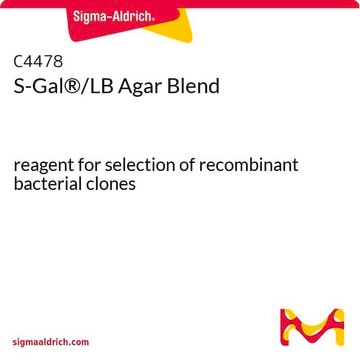S7313
S-Gal® sodium salt
reagent for selection of recombinant bacterial clones
Synonyme(s) :
3,4-Cyclohexeneoesculetin-B-D-galactopyranoside sodium salt
About This Item
Produits recommandés
Qualité
for molecular biology
Stérilité
non-sterile
Pureté
≥95% (HPLC)
Forme
powder
IVD
not for in vitro diagnostic use
Solubilité
H2O: 100 mg/mL
Adéquation
suitable for β-galactosidase test
Température de stockage
room temp
Description générale
Application
Caractéristiques et avantages
- More intense color contrast than X-gal
- Water-soluble and autoclavable for easiest use
- Excellent for use in automated colony counters
- No need to make stock solutions
Autres remarques
formulation. A medium prepared with S-Gal® is moderately dark due to the presence of ferric ammonium citrate. This darker background often provides enhanced contrast for automated colony counting or isolation.
Attention
Principe
Liaison
Reconstitution
Informations légales
Produit(s) apparenté(s)
Code de la classe de stockage
11 - Combustible Solids
Classe de danger pour l'eau (WGK)
WGK 3
Point d'éclair (°F)
Not applicable
Point d'éclair (°C)
Not applicable
Équipement de protection individuelle
Eyeshields, Gloves, type N95 (US)
Certificats d'analyse (COA)
Recherchez un Certificats d'analyse (COA) en saisissant le numéro de lot du produit. Les numéros de lot figurent sur l'étiquette du produit après les mots "Lot" ou "Batch".
Déjà en possession de ce produit ?
Retrouvez la documentation relative aux produits que vous avez récemment achetés dans la Bibliothèque de documents.
Les clients ont également consulté
Notre équipe de scientifiques dispose d'une expérience dans tous les secteurs de la recherche, notamment en sciences de la vie, science des matériaux, synthèse chimique, chromatographie, analyse et dans de nombreux autres domaines..
Contacter notre Service technique







